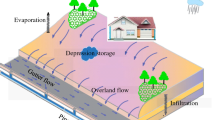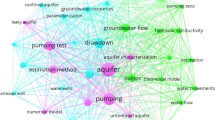Abstract
Steady- and transient-state simulations of groundwater flow and particle movement in the sub-watershed of the river Labe in Děčín town was carried out using Visual MODFLOW software. The simulations were performed for calibration and for the scenarios that the change in the water level of the river Labe was undergoing. Steady-state simulation was carried out for the sake of calibration of model outputs. For transient simulation, two different scenarios were considered in order to investigate the response of the aquifer system to the stresses applied on surface water of the river. The simulation results have shown that the surface water and groundwater interactions, and the subsequent particle movement were affected by the stresses applied on the surface water in the river Labe. The first scenario involved the rapid recharge of surface water to the aquifer in the vicinity of the river while particles still move towards the river at the places far away from the river. At the end of the second scenario, particles still tend to move towards the river slowly and finally tend to stay within the aquifer as equilibrium of hydraulic gradient is reached between the surface and groundwater levels. The time series graphs of hydraulic heads at all observation wells show that the groundwater level in the surrounding aquifer rises significantly as a result of recharges from the river. The local water balance of the study area was calculated and expressed as the rates of water entering and leaving the system. At the end of the second scenario, the difference between the rate of flow into and out of the model area was 0.73 m3 day−1.














Similar content being viewed by others
References
An, Q., Wu, Y., Talyor, S., & Zhao, B. (2009). Influence of the three gorges project on saltwater intrusion in the Yangtze River estuary. Environmental Geology, 56(8), 1679–1686.
Arntzen, et al. (2006). Effects of fluctuating river flow on groundwater/surface water mixing in the hyporheic zone of a regulated, large cobble bed river. River Research and Applications, 22, 937–946. doi:10.1002/rra.947.
Chen, W. B., Liu, W. C., & Huang, L. T. (2013). The influences of weir construction on salt water intrusion and water quality in a tidal estuary—assessment with modeling study. Environmental Monitoring and Assessment. doi:10.1007/s10661-013-3165-8.
Cooper, H. H., Jr., & Rorabaugh, M. I. (1963). Groundwater and bank storage due to flood stages in surface streams, U.S. Geol. Surv. Water Supply Pap, 1536-J, 23 pp.
Elbe River Basin (2009). International commission for the protection of the Elbe River; retrieved on 2013-04-12.
Francis, B. A., Francis, L. K., & Cardenas, M. B. (2010). Water table dynamics and groundwater-surface water interaction during filling and draining of a large fluvial island due to dam-induced river stage fluctuations. Water Resources Research, 46, 5.
Fritz, B. G., & Arntzen, E. V. (2007). Effect of rapidly changing river stage on uranium flux through the hyporheic zone. Ground Water, 45(6), 753–760. doi:10.1111/j.1745-6584.2007.00365.x.
Georgiou, I. Y., McCorquodale, J. A., Schindler, J., Retana, A. G., FitzGerald, D. M., Hughes, Z., et al. (2009). Impact of multiple freshwater diversions on the salinity distribution in the Pontchartrain Estuary under tidal forcing. Journal of Coastal Research, SI54, 59–70.
Harbaugh, A. W., Banta, E.R., Hill, M.C. & McDonald, M.G. (2000). MODFLOW-2000, The U.S. Geological Survey modular ground-water model—user guide to modularization concepts and the groundwater flow process. United States Geological Survey. Open-File Report 00–92.
Idelovitch, E., & Michail, M. (1981). Treatment effects and pollution dangers of secondary effluent percolation to groundwater. Water Science and Technology, 13, 949–966.
Larkin, R. G., & Sharp, J. M. (1992). On the relationship between river basin geomorphology, aquifer hydraulics, and groundwater flow direction in alluvial aquifers. Geological Society of America Bulletin, 104, 1608–1620. doi:10.1130/0016-7606(1992)104<1608:OTRBRB>2.3.CO;2.
Nilsson, C., Catherine, A. R., Dynesius, M., & Revenga, C. (2005). Fragmentation and flow regulation of the world’s largest river systems. Science, 308(5720), 405–408. doi:10.1126/science.1107887.
Pollock, D. W. (1989). MODPATH, documentation of computer programs to compute and display pathlines using results from U.S. Geological Survey modular three-dimensional finite difference groundwater flow model, U. S. Geological Survey Open Report 89–381, 188 pp.
Ryzhenko, B. N. (2011). Technology for predicting groundwater quality: application of physicochemical numerical simulations in evaluating groundwater pollution hazards. Preparing water supply intakes. Geochemistry International, 49, 196–198.
Sierra, J. P., Sanchez-Arcilla, A., Figueras, P. A., Gonzalez Del Rio, J., Rassmussen, E. K., & Mosso, C. (2004). Effects of discharge reductions on salt wedge dynamics of the Ebro River. River Research and Applications, 20(1), 61–77.
Sophocleous, M. (2002). Interactions between groundwater and surface water: the state of the science. Hydrogeology Journal, 10(1), 52–67. doi:10.1007/s10040-001-0170-8.
Watry, G. (2007). Introduction to quantum GIS tutorial version Florida State University, Center for Ocean-Atmospheric Prediction Studies.
Wu, Y. Q., & Ma, C. W. (2011). Remediation technology of groundwater contaminated by perchloroethylene. International Journal of Environment and Pollution, 45, 176–185.
Acknowledgments
This work was supported by the research program of the Czech University of Life Sciences MSM6046070901 “Sustainable agriculture, quality of agricultural products, sustainable use of natural and landscape resources” and partly also by the EU project EDUWAT (2010–2013). The authors are grateful to the anonymous reviewers for their time and effort.
Author information
Authors and Affiliations
Corresponding author
Rights and permissions
About this article
Cite this article
Matula, S., Mekonnen, G.B., Báťková, K. et al. Simulations of groundwater-surface water interaction and particle movement due to the effect of weir construction in the sub-watershed of the river Labe in the town of Děčín. Environ Monit Assess 186, 7755–7770 (2014). https://doi.org/10.1007/s10661-014-3964-6
Received:
Accepted:
Published:
Issue Date:
DOI: https://doi.org/10.1007/s10661-014-3964-6




